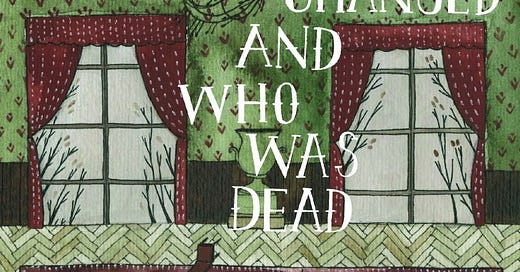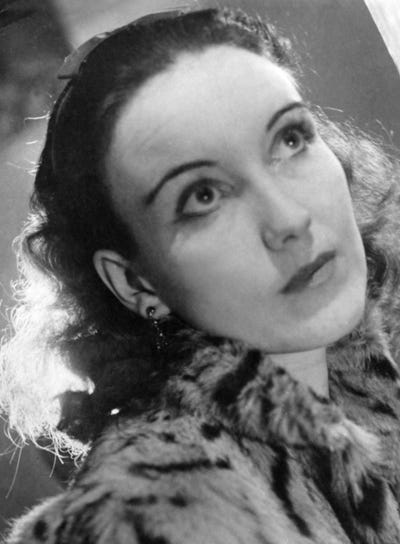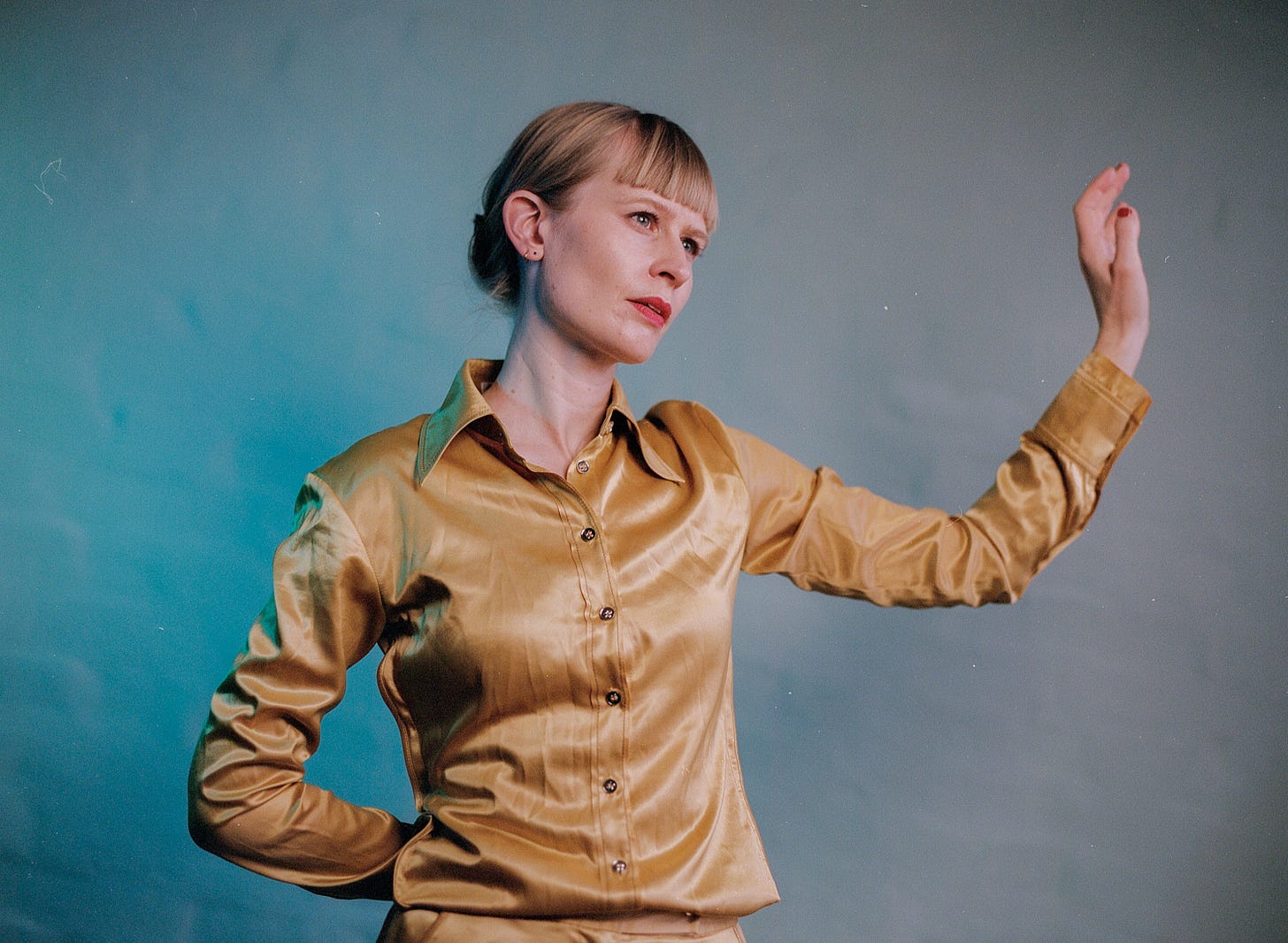Some months into the 2020 lockdown, I signed up for Alana May Johnson’s book subscription club. For a reasonable fee, she’d select and ship a new book every month, and the club members could discuss their latest reads in a twitter group chat. Following a variety of true crime, quasi-fiction, poetry, and memoir, Alana— an LA-based children’s librarian with a gift for curation — chose Barbara Comyns’ strange little 1954 novel Who Was Changed and Who Was Dead. The book had been reissued in 2010 by a small press called Dorothy, and again in January of 2021, by Daunt Books, with press materials calling it “a twisted pandemic parable,” which I guess it is.
Towards the middle of the book, a mysterious illness spreads through a quaint English village, driving sane men to cut their own throats and children to scream all night in agony.
But the story isn’t really about that, nor is it really about the flood that puts the town underwater in the first page, sending ducks swimming through the drawing room window, and pigs, “pink and dead” floating down the street, while the maids continue to make breakfast, laughing and screaming in thigh-deep water.
Characters include a mean, decrepit matriarch, her delusional and self-involved widower son, his various put-upon children, and a colorful variety of laborers and townspeople. But these people, put forth via an omniscient narrator, don’t so much drive the plot as respond as best they can to nature’s various beauties and cruelties.
From what I’ve read since of Comyns wonderful oeuvre, Who Was Changed is an outlier in tone and structure. The Vet’s Daughter, Our Spoons Came from Woolworths and The Juniper Tree all feature beleaguered female narrators, all of them as matter-of-fact and un-self-pitying as a person can be. In the introduction for the NYRB edition of The Juniper Tree, Sadie Stein describes Comyn’s style as “unsentimental magical realism, in which the odd rich detail shines out of an otherwise abstract field.” Like Who Was Changed, these are not so much plot-driven novels as engaging, sometimes harrowing, accounts of events. Comyns considered herself an artist first, and began writing stories to entertain her children. It’s unsurprising, then, that her books flow like bedtime stories, as if a child is sitting next to her asking over and over, “And then what happened?”
The women in these books are fully realized and original, even as they follow fairytail-esque trajectories. They say things like, “Labor pains are not so bad as I expected, but very deep and primitive, not like any other pain. Perhaps some women become addicted to them and that’s why they have so many children.”
As the pandemic shrinks and flips and expands and folds over itself, I find that I think about Who Was Changed often. It feels, in a way, like a companion for seemingly uncharted territory, a bit of prescience and precedent for “unprecedented times.” Apocalyptic art felt comforting during the early days of lockdown because it felt like reality reflected back. Who Was Changed reflects how things feel now: life goes on, even in the midst of horror and chaos.
At the time of publication, Who Was Change and Who Was Dead was banned in Ireland, but even knowing Ireland’s love of banning books it’s not clear why. There is some seriously disturbing imagery: Suicide is committed by man and animal alike. But what might be more troubling is the cool distance of the narration: Comyns is thorough and colorful and sometimes even whimsical in her detail, but doesn’t direct the reader’s emotions. Characters react to the things they’re seeing, but how we’re supposed to feel about what’s happening? That’s not so clear. That can be upsetting. But when, stuck in our internet feedback loops, everyone is telling us how to feel about all kinds of things, Comyns offers the freedom to feel confusion.
The other week I went to see Jenny Hval and her band at PhilaMOCA, a small DIY art space in a former mausoleum showroom not far from Center City. It had been years since her last Philadelphia show, but she claimed to remember it fondly. Since then, she said, so much has happened to her, to us, to the world. “Hopefully we can play something that’s not about that,” she laughed, and the audience, charmed from the start, laughed too.
The last time she played Philadelphia I barely knew her work, (and I didn’t live in Philadelphia). Her breakout release, Innocence is Kinky struck me as screechy art school nonsense, and I was further put off by the enthusiasm of certain young male music-critic colleagues, who I considered to be suckers taken in by any Pitchfork PR push. I’ll admit now that I was wrong, and in recent years my love for this Norwegian singer/songwriter/novelist has steadily grown into something that teeters on obsession. In retrospect its for the best that I waited to give Hval an honest shot, I hadn’t been ready.
Around the time I finally heard 2015’s Apocalypse, Girl, I’d made a deal with myself that I’d give it until I was 35 — three years away, at that point — to decide if I really wanted to have kids. My boyfriend of two years had established within a week of dating that he was not “the kind of person who wanted kids,” as he phrased it, and I was already at least halfway in love and said, sincerely, “I don’t care either way!”
Some time later I made myself lunch in his kitchen and listened to Hval sing,
Statistics and newspapers tell me I am unhappy and dying
That I need a man and child to fulfill me
That I’m more likely to get breast cancer
And it’s biology
It’s my own fault
It’s divine punishment of the unruly
Removed from the context of Hval’s crystalline voice and improbably acrobatic melodies I’m not sure that I consider this a particularly great bit of poetry. Nor is it a ground-shaking sentiment, nor a rare subject of exploration in art. Personally, I’ve been stressing about such things since I was 12. My then-boyfriend simply found it depressing, and not music to listen to over lunch.
When I was 12 Hval probably would have given me nightmares. As an adult, her fixation on womanhood’s inherent body horror is comforting on a primal level. The cumulative impact of her output, including her unsettling, grotesque and genuinely erotic novel Paradise Rot, is cathartic.
Nearly any portrayal of womanhood in art is judged, in one way or another, by whether it conforms to or subverts gender norms and/or popular trends in feminist theory. Hval doesn’t escape this oppressive dynamic — who can? — but she airs it out. Her songs are intensely emotive but unsentimental. She picks up pain and, with curiosity, turns it over in her hand.
Everything that I write/begins with the question/what’s wrong with me?
The reality of certain biological urges, such as one might diagnose as “baby fever,” are (in my experience) humiliating when they really start to kick in. The idea that I, too, am susceptible to this hormonal push and pull is an indignity. That might be why resentment for my aforementioned fanboy colleagues lingers: What, I imagine sneering, could you possibly understand about this?
But Hval is not ‘music for woman.’ Like PJ Harvey, a true master of not-so-binary expression, she plays with a conceptual and aesthetic androgyny that is intensely carnal and also otherworldly, and can be a source of vicarious freedom.
At PhilaMOCA Hval wore a silk shirt/satin pants combo that recalled the leggy sharpness of Bowie’s Thin White Duke. Everything about her seems angular. Where her records can feel slightly chilly, her 6-piece band brought warmth, and Hval was funny and relaxed and her voice sounded exquisite. Her set was almost entirely made up of songs from her lovely new pop record, The Age of Love and everyone seemed very pleased.
The first time I read Knausgaard — another Norwegian with whom I’m now obsessed— I had the epiphany that men are human. Hval reminds me that women are human too.






Totally want to read this now!